If you are thinking about visiting New Orleans and have some qualms about the safety of the city, we got you covered.
We are going to deep dive into the statistics, look at some maps, graphs and talk to the residents of the city to give you a better understanding of how safe New Orleans really is.
What is New Orleans’ crime rate?
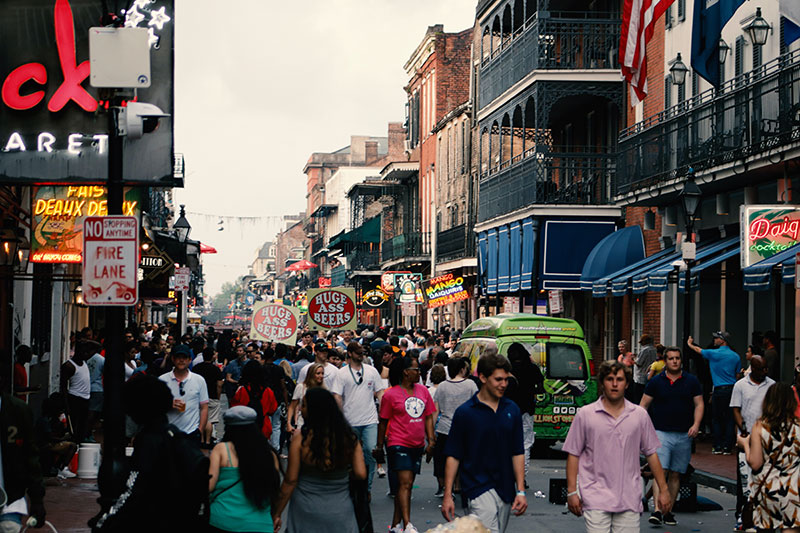
In 2020 New Orleans reported 5,215 violent crimes and had a crime rate of 1358.1 per 100,000 people. New Orleans’s crime rate is 3.4x greater than the national average.
Here’s a scale to give you some perspective on New Orlean’s crime rate:

New Orleans’ crime rate breakdown
Violent Crime Rate
In 2021, New Orelans reported 201 homicides, 712 rapes, 1,106 robberies and 3,196 aggravated assaults.
New Orleans had the 14th highest violent crime rate in the country in 2020.
New Orleans’s violent crime rate is 2.1x greater than the state average.
New Orlean’s has a similar crime rate to Albuquerque, Baltimore and Kansas City.
Here’s a map showing you how violent crime has trended in New Orleans over a 30 year period. Violent crime peaked in 1990 when there were 11,227 violent crimes reported and the city had a violent crime rate of 2259.23 per 100, 000 people.
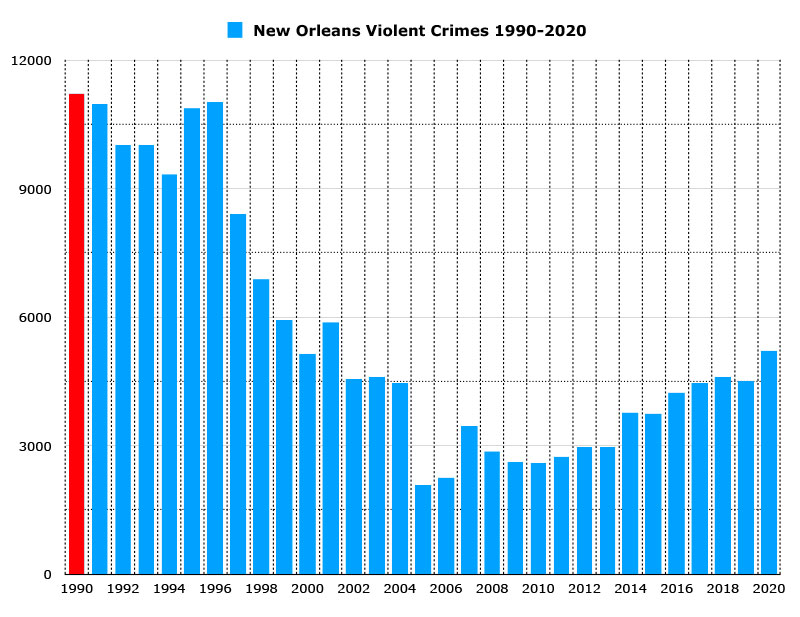
*Violent crimes include; homicides, rape, robbery and aggravated assaults and the violent crime rate is calculated by dividing the number of reported crimes by the total population; the result is multiplied by 100,000.
Property Crime Rate
In 2020 New Orleans reported 17,876 property crimes and had a property crime rate of 4,655.24 per 100,000 people.
In 2020 New Orleans reported 1,994 buglaries, 12,358 larcenies and 3,524 motor vehicle thefts.
New Orleans’s property crime rate is 2.4x greater the national average and 1.6x greater than the state average.
Here’s a map showing you how property crime has trended in New Orleans over a 30 year period. Property crime peaked in 1990 when there were 50,572 property crimes reported and the city had a property crime rate of 10,176.72 per 100, 000 people.
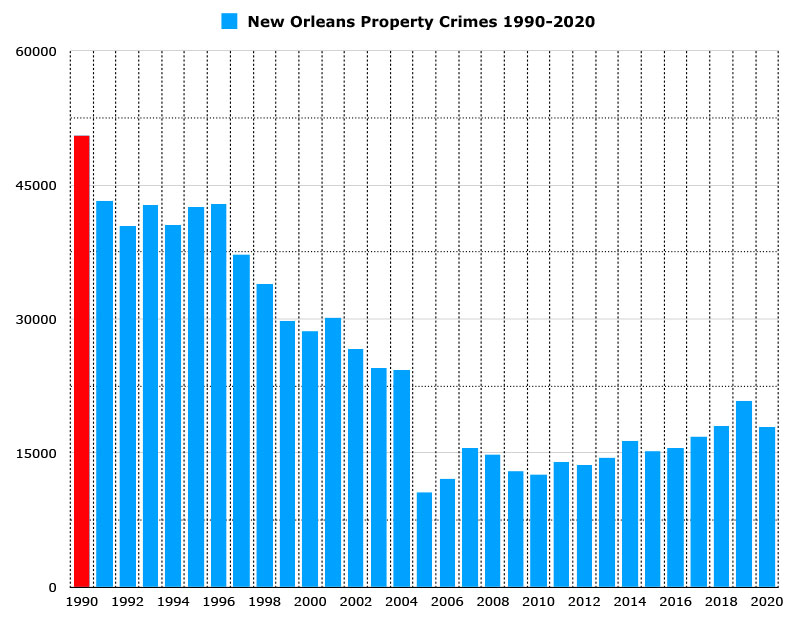
**Property crimes include; arson, burglary, larceny-theft, and motor vehicle theft are classified as property crimes. The property crime rate is calculated by dividing the number of reported crimes by the total population; the result is multiplied by 100,000.
Murder Rate
In 2020 New Orleans reported 201 homicides, which was a 65.3% increase over 2019, where 121 homicides were reported.
- 201 is the most number of homicides reported in New Orleans since 2011 where 200 homicides were recorded.
- In 2020 New Orleans had a murder rate of 52.34 per 100,000 residents and had the 5th highest murder rate in the nation.
- The national murder rate is 6.5 per 100,000 people. New Orleans’s murder rate is 8x greater the national average.
- As of Dec. 1, 2021, there have been 189 homicides reported and is expected to exceed over 200 homicides.
- New Orleans has had the highest murder rate 12 times since 1993, with 424 murders in 1994 and a staggering murder rate of 86 murders per 100,000 residents.
Here’s a map showing you how murder has trended in New Orleans over a 30 year period. Murders peaked in 1994 when there were 424 murders reported and the city had a murder rate of 85.32 per 100, 000 people.
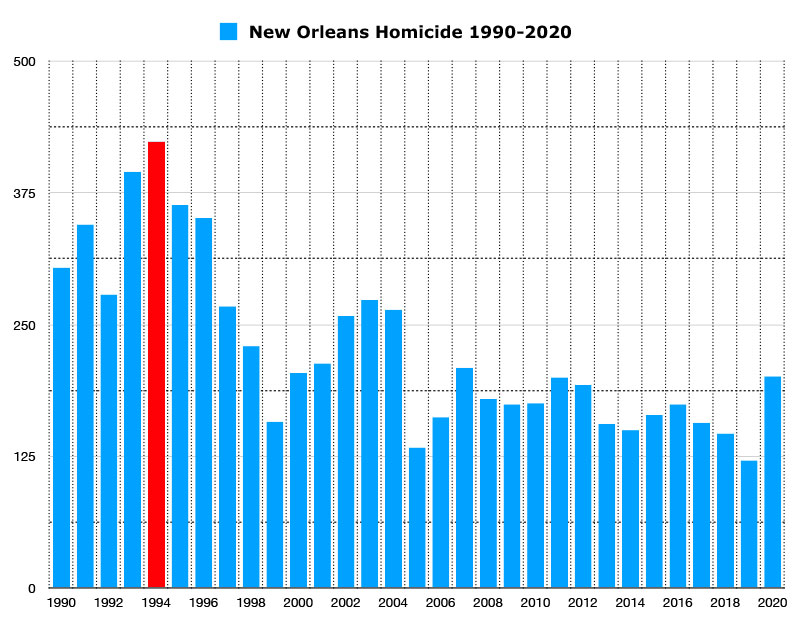
New Orleans vs The Most Dangerous Cities In The United States
Here’s a list of the top 17 most dangerous cities in the United States ranked by violent crime rates. New Orleans ranks 10th on most dangerous cities in the United States.
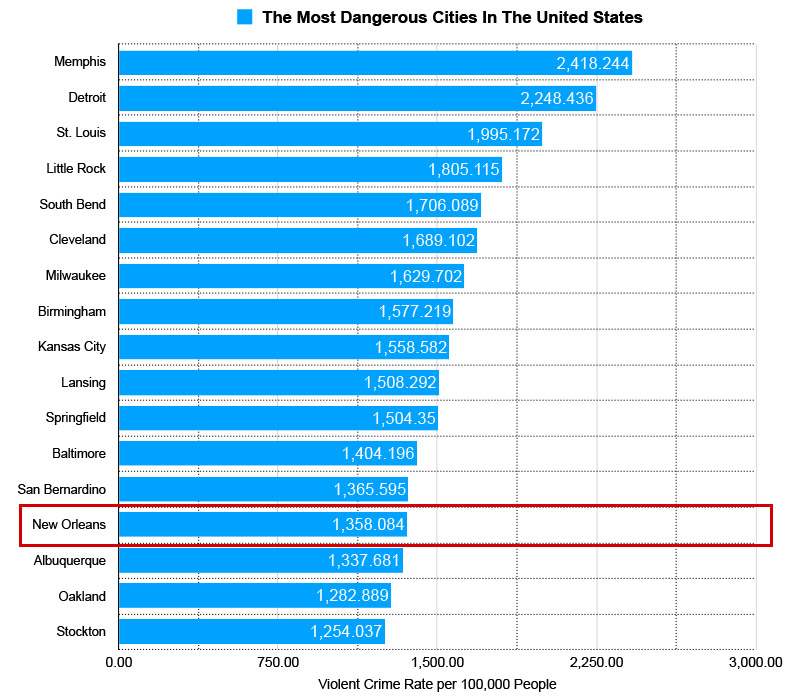
[table id=9 responsive=scroll /]
*All data is from the 2020 FBI UCR
New Orleans Crime Stats (2020)
Here’s a breakdown of all the crimes in New Orleans for 2019 and 2020.
|
|
2019 |
2020 |
2019 vs 2020 |
|
Murder |
121 |
201 |
+65.3% |
|
Rape |
774 |
712 |
-8.0% |
|
Robbery |
1,013 |
1,106 |
+9.2% |
|
Aggravated Assault |
2,608 |
3,196 |
+22.5% |
|
Burglary |
2,143 |
1,994 |
-7.0% |
|
Larceny/Theft |
15,785 |
12,358 |
-21.7% |
|
Motor Vehicle Theft |
2,951 |
3,524 |
+19.4% |
|
TOTAL |
25,395 |
23,090 |
-9.1% |
*All data is from the FBI UCR
How much has crime increased in New Orleans?
In 2020, New Orleans reported 23,090 total crimes, which is a 9% decrease over 2019.
In 2020, New Orleans reported 5,215 violent crimes, which is a 15.5% increase over 2019.
In 2020, New Orleans reported 201 murders, which is a 65.3% decrease over 2019.
In 2020, New Orleans reported 40,966 property crimes, which is a 11.5% decrease over 2019.
Most Dangerous Neighborhoods In New Orleans
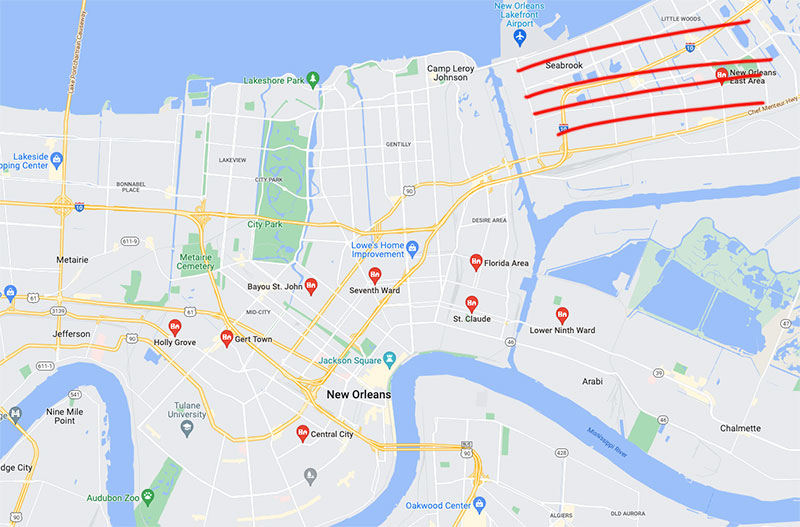
- East New Orleans
- Central City
- Holly Grove
- Saint Claude
- Seventh Ward
- Lower Ninth Ward
- Gert Town
- Florida Area
- Bayou St John
Safest Neighborhoods of New Orleans
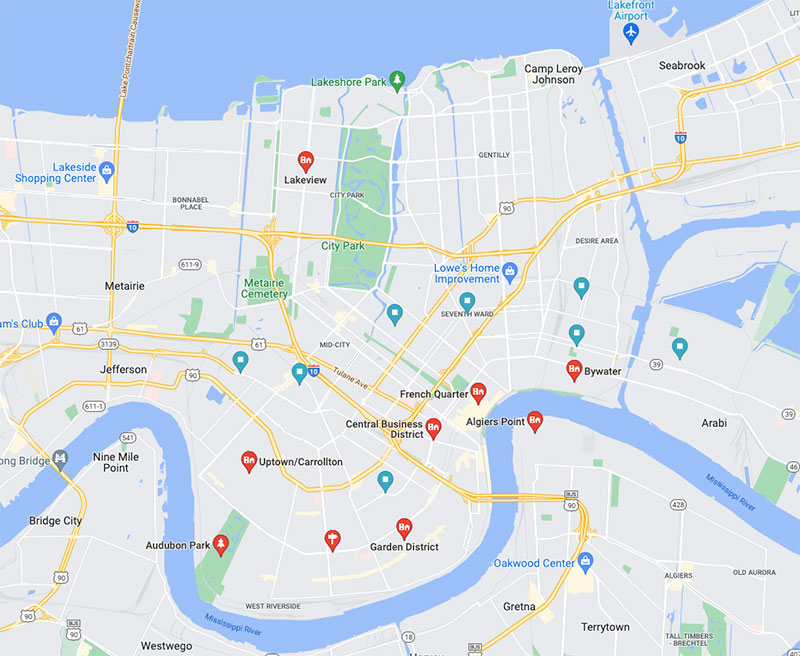
- French Quarter
- Central Business District
- St. Charles Ave
- Garden District
- Carrollton
- Audubon Park
- Lakeview
- Algiers’ Point
- Bywater
What do residents of New Orleans say about its safety
- "New Orleans isn’t divided into good and bad areas, there are multi-million dollar homes two blocks away from section 8 housing."
- "Don’t go to the 9th Ward at night."
- "Stay in the French Quarter, the Central Business District, or along St. Charles ave and stick to areas where tourists go and you will be fine"
- "Avoid east New Orleans and the 9th Ward."
- "If you stick to the French Quarter and the touristy areas you will be fine. If you wander off aimlessly at night, you might find some trouble."
- "Avoid the 9th Ward entirely."
- "East New Orleans is also known as the Compton of the South. Take what you will with that."
- "The zoning situation is unique in New Orleans, where areas of affluence are adjacent to the sketchy areas. The implication of this for tourists is that they can be walking in a safe area, walk a few blocks and find themselves in danger."
- "This map of New Orleans is pretty accurate."
- "I have lived here 52 years and I find that the crime has gotten worse in the past few years. These criminals appear to be getting more desperate."
- "The areas that you want to avoid, especially after dark, are Central City aka the homicide capital of New Orleans, Hollygrove aka the drug capital of New Orleans, New Orleans East aka the Wild West and the Lower Ninth Ward, an area devastated by Katrina and was never properly rebuilt."
- "Stay in the French Quarter, the Riverfront complex, Canal Street, and the Warehouse District."
- "New Orleans is a big small city and there’s not really a huge distance between good areas and bad areas. It almost block by block. I live in a good area and there is a 10 block stretch within walking distance of my place that I would never, ever think of walking at night.
" - "Is New Orleans safe? It really depends on your definition of safety. If you are only used to life in a suburban bubble, with well manicured lawns and white picket fences, than New Orleans might be very jarring for you. If you are a seasoned traveler, who’s been to New York, Los Angeles, or Chicago, than New Orleans will just be like any other city and you will have a blast."
Tips to stay safe while visiting New Orleans
- Don’t walk anywhere at night by yourself – take an Uber or a taxi. If you’re not familiar with your surroundings, you could very easily wander into a bad neighborhood
- Don’t look or act like a tourist if you can help it. Wearing Mardi Gras beads everywhere (especially not during Mardi Gras) makes you look like a mark.
- Plan out your routes before you leave. Don’t be looking at a map on your phone. Pay attention and walk with a purpose.
- Walk on the side of the street that the cars are not parked on, it makes it harder for someone t to jump out and surprise you.
- If you feel uncomfortable, go towards the nearest crowd or bar. Don’t head away from the populated areas and don’t go down empty streets.
- Stay in well lit areas in the quarter at night and if you notice the crowds are gone, you’ve gone too far.
- Don’t talk to or engage with any sketchy people. Just keep walking.
- Don’t get too drunk. That’s usually how bad stories start.
- Don’t get involved with prostitutes.
- Don’t go sightseeing at night.
- Don’t walk around with expensive items of clothing, jewelry or personal gear (cameras, laptops, etc.)
- If some person on the street approaches you and ask you “bet I know where you got them shoes!”, just say, “I live here, please move on.
- Don’t go searching for drugs or looking for drug dealers. You can avoid a lot of headache if you stay away from these elements.
- Don’t use public transportation at night. Uber is a better option.
- Travel in groups, there is safety in numbers.
- When you arrive in the city, talk to some of the locals about where you should and shouldn’t go.
- The most common crime in a crowded area is pickpocketing. Make sure all your belongings are secure. Keep your wallet in you front pocket. Pickpocket often work in pair, where one person will distract you, while the other makes away with your phone or wallet.
- Get back to your hotel before 1am. After midnight, the predators come out in numbers in the Quarter, and guess who the prey is?
- Stay out of the cemeteries unless you’re with a group of people. Yes, even during the day.
- Avoid taking out money from the ATM late at night, especially in a sketchy area.
- If you see a dispute – get away from it. Don’t stare or gawk, just leave.
Is New Orleans safe at night? / Is it safe to visit alone?
New Orleans can be a safer place to visit if you study the layout of the city and avoid the problem areas and also follow the safety tips posted above. Safety is never guaranteed in a high crime city.
Is New Orleans Safe?
Stastically speaking New Orleans is not safe. It consistently ranks on the list of most dangerous cities in the United States. Is violent crime rate ranked 14th highest and its murder rate ranked 5th highest in the nation.
In terms of crime, it is a city that is comparable to Baltimore, Detroit, and St. Louis, and is at least an order of magnitude more dangerous than New York or Los Angeles.
People who live in New Orleans have been acclimated to high levels of violent crime and they consider it to be “normal.” and this is made clear when statements like “it’s about average” or “no worse than other cities” are thrown around.
New Orleans has a murder rate about 6x higher than NYC or LA and it’s violent crime rate is about double. These figures vary every year, but regardless you are way more likely to get murdered or be victim of violent crime in New Orleans.
If you are traveling to New Orleans we recommend that you, at minimum, learn the layout of the city and figure out which areas are good and which areas are bad. Avoid east New Orleans, avoid Central City, avoid Seventh Ward, avoid Hollygrove, etc. New Orleans is a not a city that you want to get lost, especially at night.
Follow the safety tips posted above and keep your wits about you. It is certainly possible to have a safe visit if you are careful; safe enough that fear shouldn’t prevent you from visiting and experiencing all the great things the city has to offer… food and music being on top of that list.
Quick Facts About New Orleans
|
|
New Orleans, Louisiana |
United States |
|
Population, Census, April 1, 2020 |
383,997 |
331,449,281 |
|
Population, Census, April 1, 2010 |
343,829 |
308,745,538 |
|
Black or African American alone, percent |
59.5% |
13.4% |
|
American Indian and Alaska Native alone, percent |
0.2% |
1.3% |
|
Asian alone, percent |
2.9% |
5.9% |
|
Native Hawaiian and Other Pacific Islander alone, percent |
0.0% |
0.2% |
|
Two or More Races, percent |
1.9% |
2.8% |
|
Hispanic or Latino, percent |
5.5% |
18.5% |
|
White alone, not Hispanic or Latino, percent |
30.7% |
60.1% |
|
Foreign born persons, percent, 2015-2019 |
5.5% |
13.6% |
|
Median value of owner-occupied housing units, 2015-2019 |
$231,500.00 |
$217,500.00 |
|
Median selected monthly owner costs -with a mortgage, 2015-2019 |
$1,714.00 |
$1,595.00 |
|
Median selected monthly owner costs -without a mortgage, 2015-2019 |
$514.00 |
$500.00 |
|
Median gross rent, 2015-2019 |
$998.00 |
$1,062.00 |
|
Language other than English spoken at home, percent of persons age 5 years+, 2015-2019 |
8.3% |
21.6% |
|
High school graduate or higher, percent of persons age 25 years+, 2015-2019 |
86.5% |
88.0% |
|
Bachelor’s degree or higher, percent of persons age 25 years+, 2015-2019 |
37.6% |
32.1% |
|
In civilian labor force, total, percent of population age 16 years+, 2015-2019 |
61.7% |
63.0% |
|
Median household income (in 2019 dollars), 2015-2019 |
$41,604.00 |
$62,843.00 |
|
Per capita income in past 12 months (in 2019 dollars), 2015-2019 |
$31,385.00 |
$34,103.00 |
|
Persons in poverty, percent |
23.7% |
11.4% |
*All data is from the U.S. Census

![Is Baton Rouge Safe? [2022 Crime Rates And Crime Stats] is baton rouge safe](https://vanlifewanderer.com/wp-content/uploads/2022/01/is_baton_rouge_safe.jpg)
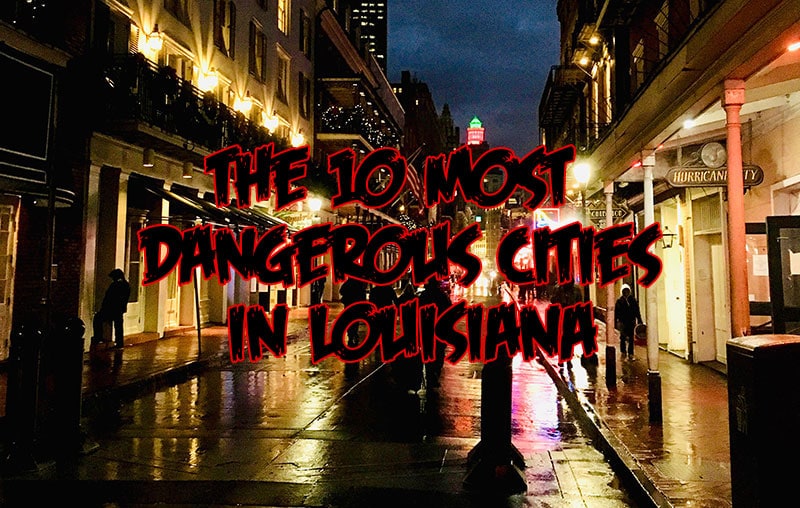
Leave a Reply